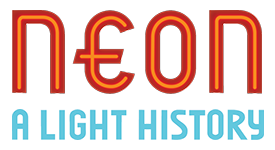

Early 1700s (UK)
Francis Hauksbee develops glass tubing and a vacuum pump to study electro-luminescence. From the outset, the manipulation of electricity is linked to luminous tubing.

Mid-1800s (Germany)
Expert glassblower Heinrich Geissler bends tiny luminous tubes into popular electro-scientific curiosities.

1890s (US)
Nikola Tesla develops wireless luminous tubing and uses it in demonstrations. He dubbed it “as lovely a phenomenon as can greet our eyes,” yet never succeeded in making luminous tubing commercially.

Beginning in the mid-1890s (US)
Daniel McFarlan Moore creates lasting luminous-tube installations using ordinary air or nitrogen. He lights exteriors, interiors, and crafts signs with words.

1898 (UK)
Sir William Ramsay and Morris Travers isolate the noble gases and name one “neon” —seeing the orange-red glow holds them “spell-bound.”

Early 1900s to 1910s
Moore tubing spreads in northeastern US and in European cities.
1909 (US)
John Madine and Russell Trimble create a commercial luminous-tube sign using neon for the Ingersoll Watch Company.

1910s (France)
Georges Claude uses Moore tubing filled with neon, then develops his own luminous-tube patents, and a company, Claude Neon Lights, franchised, after WWI, around the world.

Beginning in the mid-1920s (US)
Neon signs appear and catch on slowly, at first in larger cities, becoming fashionable symbols of modernity. American companies with their own patents, compete with Claude Neon companies.

Beginning in the 1920s to 1930s (US)
As US highway miles expand, neon signs light not just urban areas, but also the roadside places in between. America’s highway landscape becomes forever linked with colorful flashing neon. Mid-1930s (Europe): Neon art emerges.

1930s (US)
Phosphorescent coatings and colored tubing allow an explosion of new colors.

1940s (US)
WWII material restrictions and blackouts put the sign industry on hold and darken existing electric signs for the duration. Then returning servicemen use the GI Bill to attend neon schools, and open mom-and-pop neon shops across the US.

End of WWII to 1960s (US)
With businesses interested in a “new look,” neon signs grow brighter using more and more tubing. As cars drive faster and faster, signs become flashier to draw in customers traveling at greater speeds. They also grow “whiter”—hiding tubing behind the new look of plastic faces. Eventually, the neon behind the plastic is deskilled to modular fluorescent tubing.

Mid-twentieth century (US)
Growing cities like Las Vegas carry neon to new heights and new lows. Neon becomes linked with gambling, drinking, and illicit sex. Old signs in poor repair come to represent the failure of neighborhoods and even of society.

1960s (US)
In step with highway beautification efforts that limit billboards, “Scrap Old Signs” campaigns demolish thousands of historic neon and incandescent signs.

1960s (US)
Inspired by European neon art, neon art emerges in the US. By the late 1970s, a movement favoring neon brings forth sign shops-as-galleries, books and magazine articles, and signs for “edgy” new businesses. Concerted efforts begin to keep neon vibrant.

1980s to 2010s (US)
Museum of Neon Art founded in 1981. Other museums follow. Neon-sign restoration efforts start small yet eventually spread across the US as people recognize neon’s historic and community value.

2010s (US)
Collectors establish open-air neon-sign parks as tourist attractions. Online groups promote neon preservation and restoration. Some sign shops in urban areas see increase in neon work.
Despite an active restoration and preservation movement, lack of broader awareness of restoration practices and misunderstanding of neon-sign materials’ historical value leads historic signs to be destroyed in conversion to LEDs. Historic signs continue to be lost. Our neon heritage needs you!
Photo Credits Top to Bottom: The Royal Society, Augustin Privat-Deschanel Traité Élémentaire de Physique, Electrical World, authors, Radio News, Leon Gimpel, American Sign Museum, Signs of the Times, American Sign Museum, Al Barna, Thomas Hawk, Gordon Sign, Bruce Nauman, Al Barna, Corky Scholl.
